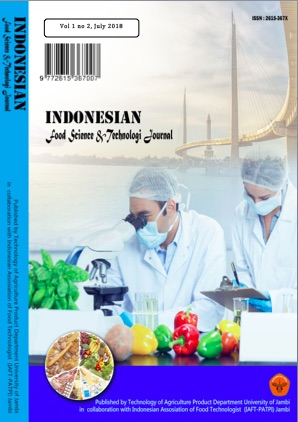Optimization of Anthocyanin Content in Uwi Flour (Dioscorea alata) Using Response Surface Methodology
DOI:
https://doi.org/10.22437/ifstj.v1i2.6006Keywords:
Dioscorea alata’s flour, anthocyanin, age of harvest, blanchingAbstract
Abstract—Main problem in the processing of Dioscorea alata’s tuber into flour is the changing of colour. One factor in color changing is attributed to antocyanin reaction in the tuber. Several methods can be applied to minimise the browning and hence maintain the natural colour preferred by the consumers. This research was conducted to obtain the combination of age of harvest, blanching temperature and blanching length which produce the highest content of antocyanin in Dioscorea alata’s flour. The responses measured was anthocyanin content. The result showed that age of harvest was the main factor for anthocyanin content of Dioscorea alata flour. The optimum anthocyanin content is predicted to be achieved by using tuber harvested at 9.6 months, temperature of blanching 86.12oC and blanching time for 0.56 menit.
Downloads
References
[2] Wang, W., & Xu, S. 2007. Degradation kinetics of anthocyanins in blackberry juice and concentrate. Journal of Food Engineering , 271-275.
[3] Akissoe, N., Hounhouigan, J., Mestres, C., & Nago, M. 2003. How Blanching and Drying Affect the Colour and Functional Characteristics of Yam (Dioscorea Cayenensis-rotundata) Flour. Food Chemstry, 82 , 257-264.
[4] Ezeocha, V., & Ojimelukwe, P. 2012. The Impact of Cooking on The Proximate Composistion and Anti-nutritional factors of Water Yam (Dioscorea alata). Journal of Stored Products and Postharvest Research, 3(13) , 172-176.
[5] Ulyarti, & Fortuna, D. 2016. Aplikasi metode simple digital imaging untuk memprediksi pembentukan warna tepung hasil pengolahan umbi uwi ungu (Dioscorea alata). Jurnal Penelitian Universitas Jambi Seri Sain , 01-08.
[6] Huang, C., Chiang, P., Chen, Y., & Wang, C. 2007. Chemical compositions and enzyme activity changes occuring in yam (Dioscorea alata L) tubers during growth. LWT , 1498-1506.
[7] Chavez-Santoscoy, R., Gutierrez-Uribe, J., Serna-Saldivar, S., & Perez-Carrillo, E. (2016). Production of maize tortillas and cookies from nixtamalized flour enriched with antocyanins, flavonoids, and saponin extracted from black bean (Phaseolus vulgaris) seed coats. Food Chemistry , 90-97.
[8] Hejtmankova, K., Kotikova, Z., Hamouz, K., pivec, V., & vacek, J. 2013. Influence of flesh colour, year and growing area on caretonoid and anthocyanin content in potato tubers. Food Composition and Analysis , 20-17.
[9] Miloslav, S., Zora, K., Lubos, P., Vladimir, P., Karel, H., & Jaromir, L. 2017. Changes in anthocyanidin levels during the maturation of color-fleshed potato (Solanum tuberosum L) tubers. Food Chemistry, http://dx.doi.org/10.1016/j.foodchem.2017.05.155.
[10] Kirca A, M. Ozkan, amd B Cemerogu. 2007. Effect of temperature, solid content and pH on the stability of black carrot anthocyanins. Food Chem, vol. 101, pp. 212-218.
Downloads
Published
Versions
- 2019-07-21 (1)
- 2019-07-21 (1)



